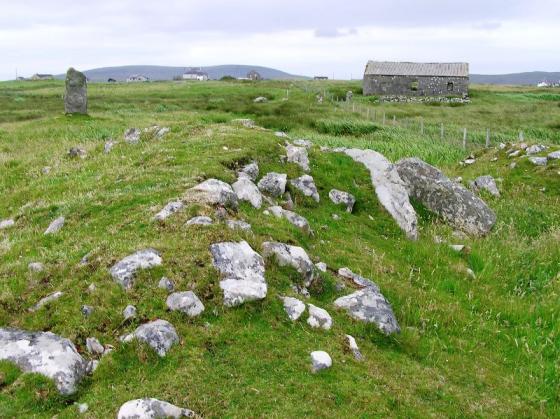
Excavated and unexcavated.

Excavated and unexcavated.

Room at the north west.

The outside was built by the excavator.

Something still lives here.

Sadly some of the walls have fallen.

Outside wall on the east side.

The walls dividing rooms/areas like a wheel hence the name.

Central hearth area.

North east room.

North section

In Loch Honaray, behind, there are 2 duns.

As high above as I could get. Stunning!

My good friend Eaval in the background.

One of the four sites at the top of the list.

General view.

Entrance.

Piers not touching outer walls.
The joining lintels are missing (or were never part of this site).

Central area.
An update to Greywether’s fieldnotes.
It is now on Canmore, has its own website and even better still there are guided tours of the wheelhouse by the excavators. Sadly for us, the chap at Port Nan Long informed us that he had been on the tour the previous night. These must be reasonably well known as the people at Grimsay Knitwear seemed to all about it as well.
The loch just to the south of the wheelhouse, Loch Honoray, contains two duns.
Go via the cottage mentioned by GW, follow the path over the hill, down the other side, jump a wee burn, climb up the other side, head east, over the gate, keep going and in a short time you’ll looking down on top the wheelhouse. The outside wall was built by the excavators who picked up non site stones to create a dry stone dyke.
We loved it, like the dun at Sticir, it was near the top of the must visit sites.
Visited 28/7/2019.
Shhhhh. This site is a secret.
It is probably the best preserved example of a very rare kind of Scottish site and this is just about the only place you will find a reference to it*. It’s not even on Canmore.
North Uist with its total indifference to heritage tourism seems not to have heard of it. There are no references to it in its tourist literature and there are no signposts or paths at the site.
Wheelhouses (see Miscellaneous for a more complete definition) date from the Iron Age and are roughly contemporary with brochs. They are found only in the Western Isles and Shetland.
I’ll let the photos tell the rest of the story. Definitely recommended for anyone visiting the Uists.
Access It’s not a difficult site to find but it is not visible until you come upon it so a good map or a GPS will help. Start by skirting the E (right) side of the cottage situated at the NW end of Loch Shornaraigh. Cross between the two inlets and head for the higher ground in front of you. Once up there, turn right through the gate and keep going for about 200m. It should be in a dip in front of you.
*One other source is the excellent but probably out-of-print The Lost Wheelhouses of Uist by Susan Hothersall and Robert Tye (2000). The definition of a Wheelhouse given below bears a strong resemblance to that given in this publication.
Visited 27 July 2004
What’s a Wheelhouse then?
Wheelhouses date from the Scottish Iron Age and are roughly contemporary with brochs. Let’s say, roughly, 500 bce to 500ce.
A wheelhouse is a circular drystone building with a single entrance. Its interior is divided by a number of stone piers arranged like the spokes of a wheel. The set of bays this creates open onto a larger, central room. The bays often seem to have had corbelled stone roofs while the larger central space could only have been roofed with timbers or whalebones.
Wheelhouses have sometimes been called “aisled round houses” because, in many cases, the stone piers – the spokes of the wheel – do not join up with the outer wall of the house. Instead, there is a gap spanned by massive lintels.
One of the best known wheelhouses is Kilpheder in South Uist excavated by Tom Lethbridge in 1952. Despite the best of intentions, there is now nothing meaningful to be seen at Kilpheder.
The only Uist site where the layout of a wheelhouse can be appreciated is at Grimsay. The few examples in Shetland are generally incorporated into other buildings making them less easy to interpret or appreciate.
Good aerial pics of the wheelhouse.
The Grimsay Wheelhouse has its own website.
Link to small book mentioned in greywether’s field notes.
The Lost Wheelhouses of Uist – a guide to some of the excavated wheelhouses of North & South Uist






























































